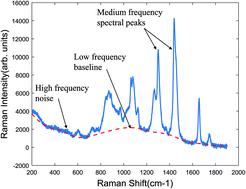当前位置:
X-MOL 学术
›
Anal. Methods
›
论文详情
Our official English website, www.x-mol.net, welcomes your feedback! (Note: you will need to create a separate account there.)
Spectral feature extraction based on continuous wavelet transform and image segmentation for peak detection
Analytical Methods ( IF 3.1 ) Pub Date : 2019-11-22 , DOI: 10.1039/c9ay02052g Guofeng Yang 1, 2, 3, 4, 5 , Jiacai Dai 1, 2, 3, 4 , Xiangjun Liu 1, 2, 3, 4, 5 , Meng Chen 1, 2, 3, 4 , Xiaolong Wu 1, 2, 3, 4
Analytical Methods ( IF 3.1 ) Pub Date : 2019-11-22 , DOI: 10.1039/c9ay02052g Guofeng Yang 1, 2, 3, 4, 5 , Jiacai Dai 1, 2, 3, 4 , Xiangjun Liu 1, 2, 3, 4, 5 , Meng Chen 1, 2, 3, 4 , Xiaolong Wu 1, 2, 3, 4
Affiliation

|
Peak detection is a crucial step in spectral signal pre-processing. The accurate locations of characteristic peaks are prerequisite for chemical identification. However, measured spectra inevitably contain both noise and baseline signals. These interference signals will generate a series of false peaks, which is a challenge for spectral analyses. For this purpose, a spectral peak detection algorithm named CWT-IS, based on continuous wavelet transform (CWT) and image segmentation (IS), is proposed. First, a wavelet coefficient matrix is obtained by CWT, then the matrix is converted to a gray image and the image is segmented by a machine vision method, an improved version of the Otsu method based on fuzzy mathematical theory. The desired threshold can be determined based on the membership grades of segmentation performance and the features of false peaks are eliminated. The fuzzy Otsu method solves the problem that the traditional Otsu method cannot effectively handle an image with a unimodal histogram, thus, this method can accurately separate peak regions from the CWT coefficient matrix and ridges representing the peaks are complete. This method has been successfully applied to the peak detection of the simulated spectra and the MALDI-TOF spectra. The experimental results show that CWT-IS can effectively eliminate the adverse effect of noise and baseline and make the features of spectral peaks become more obvious, which is conducive to determine characteristic peak positions.
中文翻译:

基于连续小波变换和图像分割的光谱特征提取用于峰值检测
峰值检测是频谱信号预处理中的关键步骤。特征峰的准确位置是化学鉴定的先决条件。但是,测得的光谱不可避免地同时包含噪声和基线信号。这些干扰信号将产生一系列假峰,这对频谱分析是一个挑战。为此,提出了一种基于连续小波变换(CWT)和图像分割(IS)的光谱峰检测算法CWT-IS。首先,通过CWT获得小波系数矩阵,然后将该矩阵转换为灰度图像,并通过机器视觉方法对图像进行分割,该方法是基于模糊数学理论的Otsu方法的改进版本。可以基于分段性能的隶属度确定所需阈值,并消除错误峰的特征。模糊大津法解决了传统大津法无法有效处理具有单峰直方图的图像的问题,因此该方法可以从CWT系数矩阵中准确分离出峰区域,并且代表峰的山脊完整。该方法已成功应用于模拟光谱和MALDI-TOF光谱的峰检测。实验结果表明,CWT-IS可以有效消除噪声和基线的不利影响,使光谱峰的特征更加明显,有利于确定特征峰的位置。模糊大津法解决了传统大津法无法有效处理具有单峰直方图的图像的问题,因此该方法可以从CWT系数矩阵中准确分离出峰区域,并且代表峰的山脊完整。该方法已成功应用于模拟光谱和MALDI-TOF光谱的峰检测。实验结果表明,CWT-IS可以有效消除噪声和基线的不利影响,使光谱峰的特征更加明显,有利于确定特征峰的位置。模糊大津法解决了传统大津法无法有效处理具有单峰直方图的图像的问题,因此该方法可以从CWT系数矩阵中准确分离出峰区域,并且代表峰的山脊完整。该方法已成功应用于模拟光谱和MALDI-TOF光谱的峰检测。实验结果表明,CWT-IS可以有效消除噪声和基线的不利影响,使光谱峰的特征更加明显,有利于确定特征峰的位置。该方法已成功应用于模拟光谱和MALDI-TOF光谱的峰检测。实验结果表明,CWT-IS可以有效消除噪声和基线的不利影响,使光谱峰的特征更加明显,有利于确定特征峰的位置。该方法已成功应用于模拟光谱和MALDI-TOF光谱的峰检测。实验结果表明,CWT-IS可以有效消除噪声和基线的不利影响,使光谱峰的特征更加明显,有利于确定特征峰的位置。
更新日期:2019-11-22
中文翻译:

基于连续小波变换和图像分割的光谱特征提取用于峰值检测
峰值检测是频谱信号预处理中的关键步骤。特征峰的准确位置是化学鉴定的先决条件。但是,测得的光谱不可避免地同时包含噪声和基线信号。这些干扰信号将产生一系列假峰,这对频谱分析是一个挑战。为此,提出了一种基于连续小波变换(CWT)和图像分割(IS)的光谱峰检测算法CWT-IS。首先,通过CWT获得小波系数矩阵,然后将该矩阵转换为灰度图像,并通过机器视觉方法对图像进行分割,该方法是基于模糊数学理论的Otsu方法的改进版本。可以基于分段性能的隶属度确定所需阈值,并消除错误峰的特征。模糊大津法解决了传统大津法无法有效处理具有单峰直方图的图像的问题,因此该方法可以从CWT系数矩阵中准确分离出峰区域,并且代表峰的山脊完整。该方法已成功应用于模拟光谱和MALDI-TOF光谱的峰检测。实验结果表明,CWT-IS可以有效消除噪声和基线的不利影响,使光谱峰的特征更加明显,有利于确定特征峰的位置。模糊大津法解决了传统大津法无法有效处理具有单峰直方图的图像的问题,因此该方法可以从CWT系数矩阵中准确分离出峰区域,并且代表峰的山脊完整。该方法已成功应用于模拟光谱和MALDI-TOF光谱的峰检测。实验结果表明,CWT-IS可以有效消除噪声和基线的不利影响,使光谱峰的特征更加明显,有利于确定特征峰的位置。模糊大津法解决了传统大津法无法有效处理具有单峰直方图的图像的问题,因此该方法可以从CWT系数矩阵中准确分离出峰区域,并且代表峰的山脊完整。该方法已成功应用于模拟光谱和MALDI-TOF光谱的峰检测。实验结果表明,CWT-IS可以有效消除噪声和基线的不利影响,使光谱峰的特征更加明显,有利于确定特征峰的位置。该方法已成功应用于模拟光谱和MALDI-TOF光谱的峰检测。实验结果表明,CWT-IS可以有效消除噪声和基线的不利影响,使光谱峰的特征更加明显,有利于确定特征峰的位置。该方法已成功应用于模拟光谱和MALDI-TOF光谱的峰检测。实验结果表明,CWT-IS可以有效消除噪声和基线的不利影响,使光谱峰的特征更加明显,有利于确定特征峰的位置。

























 京公网安备 11010802027423号
京公网安备 11010802027423号